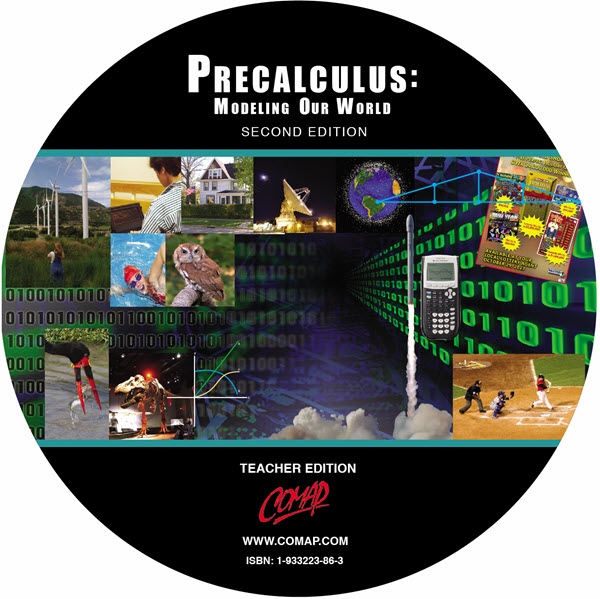Precalculus: Modeling Our World 2nd Edition (Teachers Edition) (CD-Rom)
Click Here To Preview Precalculus: Modeling Our World
This is a different precalculus text. It contains all of the topics that you would expect to find in a precalculus text and more; but it is a text written by COMAP and applications is our middle name. Thus you will see the concepts and skills of precalculus presented from an applications and modeling point of view. Moreover, this is an activity and problem-solving based book. We want students to experience the mathematics they are learning in a way that will make both the mathematics and the contemporary applications come alive.
We make serious use of graphing calculators and a variety of software, including spreadsheets and geometric utility programs. We introduce and make use of data analysis techniques. All of which permit us to analyze deeper and more meaningful problems. And we have attempted to add material that will in fact, as well as name, better prepare students for their work in calculus from our introductory work on functions to our final chapter on finite difference equations. We use a spiraling approach, coming back to earlier ideas in later chapters, so that we can keep those ideas, concepts, and skills alive, reinforcing their importance as well as providing additional practice.
New Features of the second edition:
- The first full-color edition.
- Updated data and news articles throughout.
- Correlation to the Common Core State Standards.
- A single electronic teacher disc that includes the student text in PDF format as well as answers, teacher notes, blackline masters, software, and test questions.
- A supplemental chapter on probability will be available separately or as an eleventh chapter through custom publishing.
- Student materials are available in CD-ROM, Print and Webportal.
CHAPTER 1
Functions in Modeling
- Introduction
- LESSON 1.1 Functions as Models
- LESSON 1.2 Creating a Mathematical Model
- LESSON 1.3 Modeling Linear Patterns: Beginning the Tool Kit of Functions
- LESSON 1.4 Expanding the Tool Kit of Functions
- LESSON 1.5 Transformations of Functions
- LESSON 1.6 Operations on Functions
- CHAPTER 1 REVIEW
CHAPTER 2
The Exponential and Logarithmic Functions - LESSON 2.1 Exponential Functions
- LESSON 2.2 Logarithmic Scale
- LESSON 2.3 Changing Bases
- LESSON 2.4 Logarithmic Functions
- LESSON 2.5 Modeling with Exponential and Logarithmic Functions
- LESSON 2.6 Composition and Inverses of Functions
- CHAPTER 2 REVIEW
CHAPTER 3
Polynomial Models - LESSON 3.1 Modeling Falling Objects
- LESSON 3.2 The Merits of Polynomial Models
- LESSON 3.3 The Power of Polynomials
- LESSON 3.4 Zeroing in on Polynomials
- LESSON 3.5 Polynomial Divisions
- LESSON 3.6 Polynomial Approximations
CHAPTER 4
Trigonometric Functions - LESSON 4.1 Oscillating Phenomena and Periodic Functions
- LESSON 4.2 The Sine Function
- LESSON 4.3 The Cosine Function
- LESSON 4.4 The Tangent and Other Functions
CHAPTER 5
Triangle Trigonometry - LESSON 5.1 Right Triangles
- LESSON 5.2 Inverses
- LESSON 5.3 Oblique Triangles
CHAPTER 6
Coordinate Systems and Vectors - LESSON 6.1 Polar Coordinates
- LESSON 6.2 Polar Form of Complex Numbers
- LESSON 6.3 The Geometry of Vectors
- LESSON 6.4 The Algebra of Vectors
- LESSON 6.5 Vector and Parametric Equations in Two Dimensions
- LESSON 6.6 Vector Equations in Three Dimensions
- CHAPTER 6 REVIEW
CHAPTER 7
Matrices - LESSON 7.1 Matrix Basics
- LESSON 7.2 The Multiplicative Inverse
- LESSON 7.3 Systems of Equations in Three Variables
CHAPTER 8
Analytic Geometry - LESSON 8.1 Analytic Geometry and Loci
- LESSON 8.2 Modeling with Circles
- LESSON 8.3 Modeling with Parabolas
- LESSON 8.4 Modeling with Ellipses
- LESSON 8.5 Modeling with Hyperbolas
- CHAPTER 8 REVIEW
CHAPTER 9
Counting and the Binomial Theorem - LESSON 9.1 Counting Basics
- LESSON 9.2 Compound Events
- LESSON 9.3 The Binomial Theorem
CHAPTER 10
Modeling Change with Discrete Dynamical Systems - LESSON 10.1 Modeling Change with Difference Equations
- LESSON 10.2 Approximating Change with Difference Equations
- LESSON 10.3 Numerical Solutions
- LESSON 10.4 Systems of Difference Equations
Teacher's Guide
Teacher's Resources
- Handouts
- Assessment Problems
- Transparencies
- Software
- Solutions Manual
- Supplemental Activities

| Author | Nancy Crisler and Gary Froelich |
| Copyright Year | ©2016 by COMAP, Inc. |
| Product Number | 7667 |
| Primary Level | High School |
| Additional Levels | Undergraduate |
| Application Areas | Precalculus, Modeling |
| Format | PDF files on a CD-Rom |
| Format Options | USB, Webportal |